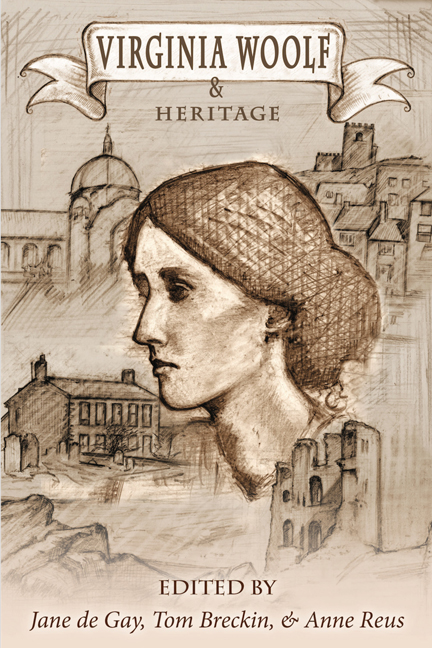Book contents
- Frontmatter
- Contents
- Introduction
- List of Abbreviations
- HERITAGE: A DEBATE
- HERITAGE, EDUCATION, AND MENTORING
- HERITAGE SPACES
- Virginia Woolf and the Artistic Heritage of St. Ives
- “The little bit of power I had myself ”: Lady Lasswade's Shifting Sense of Place in The Years
- Through the Arch: The Country House and the Tradition of English Tyranny in Woolf 's Between the Acts
- Heritage Hoarding: Artifacts, Archives, and Ambiguity, or, the Saga of Virginia Woolf 's Standing Desk
- “Against you I will fling myself, unvanquished and unyielding, O Death!”: Vanessa Bell's Death of the Moth Dust Jacket as Monument to Virginia Woolf
- LITERARY AND CULTURAL HERITAGES
- QUEER PASTS
- MODERNISM AND HERITAGE
- WRITING LIVES AND HISTORIES
- WOOLF'S LEGACIES
- FINALE
- Notes on Contributors
Virginia Woolf and the Artistic Heritage of St. Ives
from HERITAGE SPACES
- Frontmatter
- Contents
- Introduction
- List of Abbreviations
- HERITAGE: A DEBATE
- HERITAGE, EDUCATION, AND MENTORING
- HERITAGE SPACES
- Virginia Woolf and the Artistic Heritage of St. Ives
- “The little bit of power I had myself ”: Lady Lasswade's Shifting Sense of Place in The Years
- Through the Arch: The Country House and the Tradition of English Tyranny in Woolf 's Between the Acts
- Heritage Hoarding: Artifacts, Archives, and Ambiguity, or, the Saga of Virginia Woolf 's Standing Desk
- “Against you I will fling myself, unvanquished and unyielding, O Death!”: Vanessa Bell's Death of the Moth Dust Jacket as Monument to Virginia Woolf
- LITERARY AND CULTURAL HERITAGES
- QUEER PASTS
- MODERNISM AND HERITAGE
- WRITING LIVES AND HISTORIES
- WOOLF'S LEGACIES
- FINALE
- Notes on Contributors
Summary
Virginia Stephen enjoyed the happiest summers of her life in St. Ives until, following the death of her mother, the lease of Talland House was sold in 1895. The Stephen family were actively involved in the St. Ives’ arts scene: Leslie and Julia were among the first to join the St. Ives Arts Club and Leslie was voted President; while in St. Ives Vanessa (Woolf records) enjoyed “painting in water-colours, and scratching a number of black little squares, after Ruskin's prescription” (MOB 31); leading local painters Louis Grier and Julius Olsson were known to the family and dined at Talland House; Vanessa, like the other painters, bought materials at Lanham's art shop which hosted the annual Studio Day; Woolf 's half-brothers played cricket when the St. Ives Artists’ Eleven played. The artist Lily Kirkpatrick lived close by in Talland Road from 1893. Many London artists, including Vanessa and Virginia's friend Eliza Ramona (Lisa) Stillman visited Talland House (Humm Companion).
St. Ives impacted on Woolf's writing in multiple ways; for example, she incorporated real-life events there, such as Leo Maxse's proposal to Kitty Lushington in Talland House garden, into To the Lighthouse thirty-seven years later. But I want to focus on the arts of St. Ives: the artists who painted light in extraordinary, original ways and whose techniques must have influenced Woolf, and whose names may well have recurred in her writing.
Critical responses to this milieu are numerous and include the scholarship of Marion Dell and Marion Whybrow on St. Ives, Diane Gillespie and Frances Spalding's work on Vanessa Bell, and Leslie Hankins’ very stimulating and playful plenary at the 2012 Woolf conference in Saskatoon imagining encounters in St. Ives between Virginia Stephen and the Canadian painter Emily Carr—who did not arrive in St. Ives until after the departure of the Stephens (Dell and Whybrow, Gillespie, Spalding, Hankins). All agree that St. Ives had a strong impact on Woolf 's writing. But it is the specific impact of St. Ives’ art on Woolf 's aesthetics which concerns this paper. Her first memories of St. Ives she recorded aesthetically “if I were a painter I should paint these first impressions in pale yellow, silver and green” (MOB 66).
- Type
- Chapter
- Information
- Virginia Woolf and Heritage , pp. 54 - 59Publisher: Liverpool University PressPrint publication year: 2017



